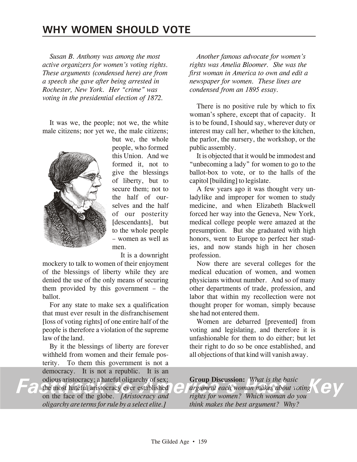| Fasttrack
to America's Past Teacher Key |
|
| Fasttrack
to America's Past Teacher Key |
|
 Page 159 |
Page 159 -
Why Women Should Vote The reading selection This page of the workbook has two short selections by famous 19th century leaders in the women's rights movement. Susan B. Anthony is the better known figure today. The selection is taken from a speech she gave after being arrested in Rochester, New York, for voting in the 1872 election. Amelia Bloomer is best known for giving her name to "bloomers," an outfit consisting of a short skirt worn over loose cut trousers tied at the ankles. The style was actually started by another reformer to liberate women from the restrictive style of women's clothing of that time. Amelia Bloomer wore the design long after others abandoned the style, however, and her name stuck. The picture Susan B. Anthony, one of the key leaders in the 19th century women's rights movement. She made her home in Rochester, New York. The house is now a museum about her life and work. Group discussion question Susan B. Anthony
argues that state
laws that allow only men to vote are unconstitutional and contrary to
the
founding principles of the United States. She uses the phrases of
the Preamble of the Constitution ("We the People...") to show that
women
were not meant to be excluded by those famous words. Amelia Bloomer's essay
is less inflammatory,
although the point is the same. She knows that gender roles are
set
by custom, which can be very rigid indeed. But she points out
that
custom can change, and even look perfectly proper once people accept
the
new
pattern. Her example is Elizabeth Blackwell, who became a medical
doctor at a time when that was thought improper for a woman.
|
|
Copyright Notice
Copyright 2018 by David Burns. All rights reserved. Illustrations and reading selections appearing in this work are taken from sources in the public domain and from private collections used by permission. Sources include: the Dover Pictorial Archive, the Library of Congress, The National Archives, The Hart Publishing Co., Corel Corporation and its licensors, Nova Development Corporation and its licensors, and others. Maps were created or adapted by the author using reference maps from the United States Geological Survey and Cartesia Software. Please see the home page for this title for more information. |